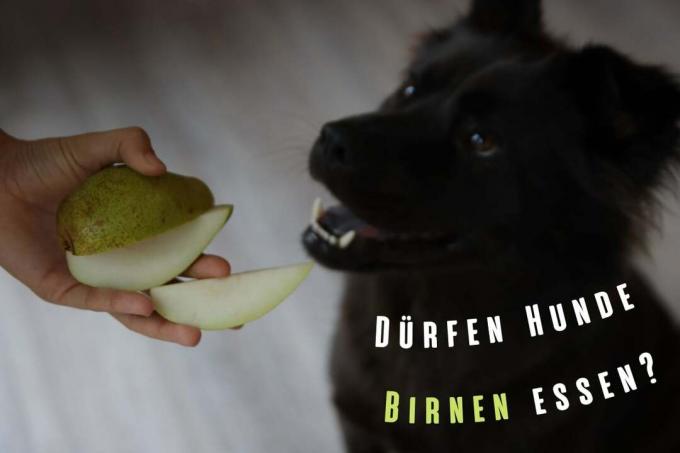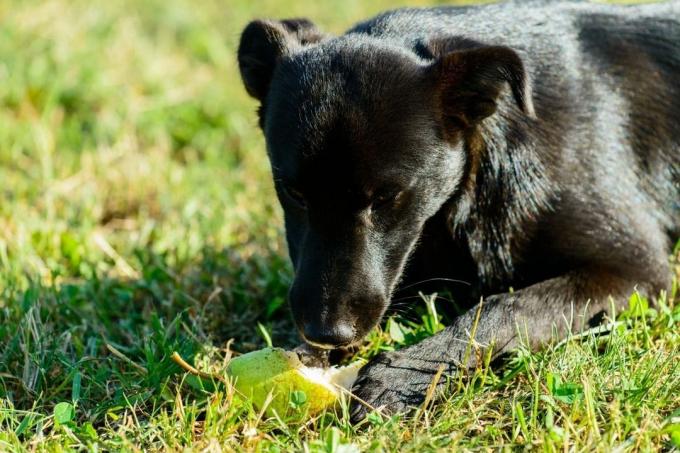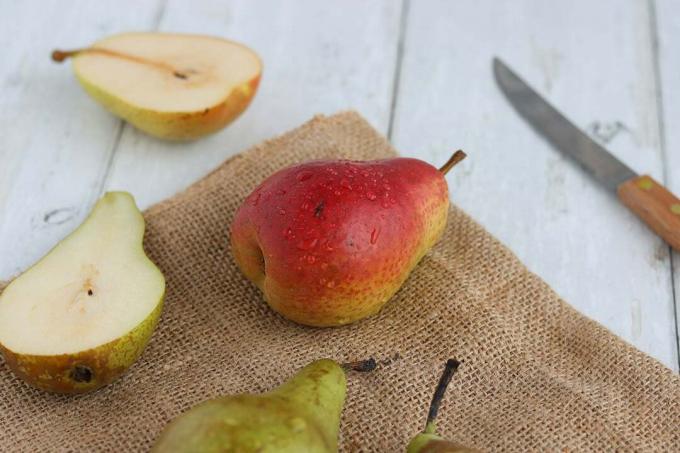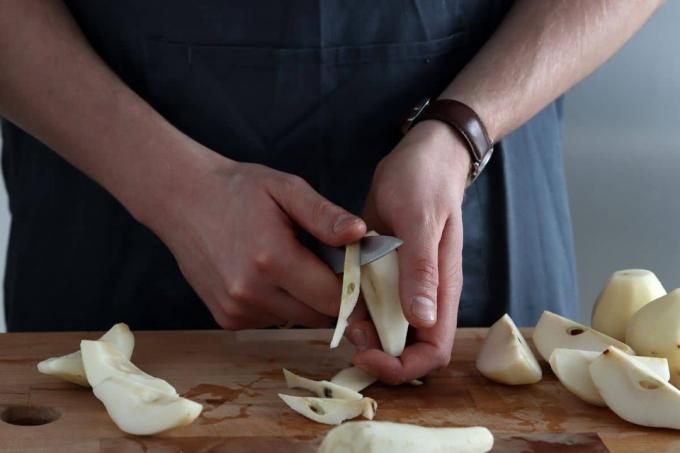
table of contents
- Dogs are carnivores
- Good for health
- Only feed overripe
- Only as a supplementary feed
- Good with diet
- frequently asked Questions
Pears are not only healthy and tasty for us humans, but also for our beloved four-legged friend, the dog. However, there are a few things to consider when feeding. More tips below.
In a nutshell
- contain many vitamins and minerals
- very low acid fruit variety
- only feed overripe
- Chop before feeding
- The cores contain hydrogen cyanide
Dogs are carnivores
Just like their ancestors, the wolves, our beloved four-legged friends are usually carnivores. However, they also need some plant-based food in between. In the case of biologically appropriate raw feeding (BARF), fruit and vegetables are a sensible addition. In addition, fruit can also be served as a small snack in between or as a treat. Pears are a good addition to any feeding plan. The valuable minerals and vitamins contained in this fruit have a positive effect on the health of dogs.

Note: Pears can be fed with a fresh meat meal or simply as a small treat.
Good for health
The pear is not only a popular fruit for us humans, our dogs also like this fruit very much. In addition, the pear is healthy for humans and animals. In all Pear varieties contain many valuable ingredients, such as
- Vitamins C, A, E and B group vitamins
- Folic acid
- potassium
- calcium
- zinc
- magnesium
These vitamins and minerals ensure that the beloved four-legged friend stays healthy and fit. The individual substances fulfill their own functions in the dog's body:
- Silicic acid strengthens the skin and connective tissue
- Copper ensures shiny fur, strengthens the immune system and builds bones
- Iron prevents anemia
- Phosphorus strengthens the nervous system
- Vitamin A supports eyesight, the immune system, bones and muscles
- Calcium is good for your bones and teeth
- Potassium ensures a healthy metabolism, regulates the fluid balance and supports muscle function
- Vitamin K ensures good blood clotting
- Vitamin C strengthens the joints and the immune system
Furthermore, the contained carbohydrates provide the four-legged friend with energy and the fiber supports digestion and influences the firmness of the feces.
Only feed overripe
The pear is a very low-acid type of fruit and has a very sweet taste. For this reason, many of the four-legged friends are so infatuated with this fruit. However, there are exceptions here, not all dogs like the pear, but the owner can certainly find that out easily. Dogs should only be fed overripe pears. These are particularly tasty and well tolerated by the animals. In this condition, this fruit is also digestible for sensitive dogs or dogs with stomach problems. The pear, just like the banana, prevents acidification in the body. However, this fruit should not only be overripe, but also fresh and of good quality, not yet rotten. Overripe pears are easy to spot:
- they give way under pressure
- the pressure point remains visible

Note: Canned pears are not suitable for feeding dogs because they have a high sugar content. The dog can get stomach and intestinal problems while feeding. Incidentally, it can also lead to weight gain.
Only as a supplementary feed
Pears should never be used as main food, only as a supplement. They are ideal as complementary foods. If possible, they should be mixed with the fresh food when barfing. The pear should ideally be mashed beforehand. The fruit is also very popular raw as a snack between meals. However, the dog should not be given a whole pear, but rather it has to be divided into bite-sized pieces. Otherwise it can happen that the four-legged friend chokes on it. Proceed as follows:
- Select overripe pears
- Remove the stem and leaves
- then wash thoroughly
- especially when fruit has been treated with pesticides
- Divide the fruit in half
- these in turn in two pieces
- Remove the fruit casing and seeds
- then cut each piece into two to three centimeters thick slices
- The size of the slices depends on the size of the dog

Of course, pears should only be fed to dogs in moderation. Large and medium-sized dogs should only be given one or two slices at intervals. One disc is sufficient for a smaller dog.
Good with diet
This fruit is also a good supplement for dogs on a diet. Such a mix could be composed as follows:
- Mash or puree the pear
- Mix this proportionately with rice or potatoes
- Mix in cooked chicken, fish or quark as a source of protein
This mixture is also good for convalescing or sick dogs because of the fructose it contains. The fructose is a real energy donor for the dog.
Note: Pear seeds are poisonous to dogs. They contain hydrocyanic acid and must be carefully removed before feeding. For this reason, the dog should never get a whole pear.
frequently asked Questions
In addition to pears, apples are also very healthy. They contain many vitamins and the fiber pectin and thus ensure a balanced digestion. In addition, papaya and pineapple are healthy due to their well-tolerated enzymes. But be careful, pineapples may only be fed when they are ripe. Unripe fruits can be fatal. Furthermore, due to the high fruit acid content of the pineapple, only small amounts should be given.
No, fruit can be fed raw. However, it must be ripe or be overripe and should be chopped or, even better, mashed. The dog can then ingest and digest the fruit well, since it lacks the enzyme that is used to break down the plant cell walls. As a result of the previous shredding, the cell structure is already largely destroyed.
The dog in question can then have more or less serious gastrointestinal problems. Among other things, diarrhea, flatulence, vomiting or abdominal cramps can occur. If necessary, a veterinarian should be consulted.
